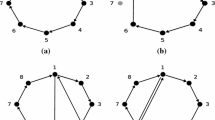Abstract
This paper presents a heuristic for solving very large routing problems (thousands of customers and hundreds of vehicles) with side constraints such as time windows. When applied to traditional benchmarks (Solomon's), we obtain high quality results with short resolution time (a few seconds). We also introduce a LDS (Limited Discrepancy Search) variation that produces state-of-the-art results. The heart of this heuristic is a combination of a look-ahead insertion algorithm, an incremental local optimization scheme and a constraint solver for constrained traveling salesman problems. The incrementality means that instead of visiting some large neighborhood after an initial solution has been found, a limited number of moves is examined, after each insertion, on the partial solution. This incremental version is not only faster, it also yields better results than using local optimization once a full solution has been built. We also show how additional constraints can be used in order to guide the insertion process. Because of its use of separate CP (Constraint Programming) modules, this method is flexible and may be used to solve large dispatching problems that include many additional constraints such as setup times (asymmetrical distance) or skill matching.
Similar content being viewed by others
References
P. Augerat, J.M. Belenguer, E. Benavent, A. Corberan, D. Naddef, and G. Rinaldi. (1995). “Computational Results with a Branch and Cut Code for the Capacitated Vehicle Routing Problem,” Artemis Imag Research Report RR949-M.
Caseau, Y. and.P. Koppstein. (1992). “A Rule-Based Approach to a Time-Constrained Traveling Salesman Problem,” 2nd Int. Symp. on AI and Mathematics.
Caseau, Y. and F. Laburthe. (1996). “Introduction to the Claire Programming Language.” LIENS Report 96-15, Ecole Normale Supérieure.
Caseau, Y. and F. Laburthe. (1997). “Solving Small TSPs with Constraints,” to appear in Proc. of the 14th International Conference on Logic Programming, The MIT Press.
Christophides, N. (1985). “Vehicle Routing.” The Traveling Salesman Problem: A Guided Tour of Combinatorial Optimization. In E.L. Lawler, J.K. Lenstra, A.H.G. Rinnooy Kan, and D.B. Shrmoys (eds.),Wiley, pp. 431–448.
Clarke, G. and J.W. Wright. (1964). “Scheduling of Vehicles from a Central Depot to a Number of Delivery Points,” Operations Research 46, 93–100.
Desaulniers, G., J. Desrosiers, I. Loachim, M.M. Solomon, and F. Soumis. A Unified Framework for Deterministic Time Constrained Vehicle Routing and Crew Scheduling Problems, cahiers du GERAD 94-46.
Dumas, Y., J. Desrosiers, E. Gélinas, and M.M. Solomon. (1995). “An Optimal Algorithm for the Traveling Salesman Problem with Time Windows,” Operations Research 43, 367–371.
Desrochers, M., J. Desrosiers, and M. Solomon. (1992). “A New Optimization Algorithm for the Vehicle Routing Problem with Time Windows,” Operations Research 40(2).
Gendreau, M., A. Hertz, and G. Laporte. (1992). “NewInsertion and Postoptimization Procedures for the Traveling Salemsan Problem,” Operations Research 40(6).
Gendreau, M., A. Hertz, and G. Laporte. (1994). “A Tabu Search Heuristic for the Vehicle Routing Problem,” Management Science 40, 1276–1290.
Harvey, W. and M. Ginsberg. (1995). “Limited Discrepancy Search.” Proceedings of the 14th IJCAI, Morgan Kaufmann, pp. 607–615.
Kindervater, G. and M. Savelsbergh. (1997). “Vehicle Routing: Handling Edges Exchanges.” Local Search in Combinatorial Optimization. In E. Aarts and J.K. Lenstra (eds.), Wiley.
Kontoravdis, G. and J. Bard. (1995). “A GRASP for the Vehicle Routing Problem with Time Windows,” ORSA Journal on Computing 7(1).
Laporte, G. (1992). “The Vehicle Routing Problem: An Overview of Exact and Approximate Algorithms,” European Journal of Operational Research 59, 345–358.
Pesant, G. and M. Gendreau. (1995). “A View of Local Search in Constraint Programming.” Proceedings of Constraint Programming, CP'96, LNCS 1118, Springer.
Pesant, G., M. Gundreau, J.-Y. Potvin, and J.-M. Rousseau. (1998). “An Exact Constraint Logic Programming Algorithm for the Travelling Salesman Problem with Time Windows,” Transportation Science 32(1), 12–29.
Potvin, J.-Y. and J.-M. Rousseau. (1993). “A Parallel Route Building Algorithm for the Vehicle Routing and Scheduling Problem with Time Windows,” Eur. Journal Op. Res. 66.
Rochat, E. and E. Taillard. (1995). “Probabilistic Diversification and Intensification in Local Search for Vehicle Routing,” Journal of Heuristic 1, 147–167.
Russell, R. (1995). “Hybrid Heuristics for the Vehicle Routing Problem with Time Windows,” Transportation Science 29(2).
Savelsbergh, M. (1985). “Local Search in Routing Problems with TimeWindows,” Annals of Operations Research 4, 285–305.
Solomon, M. (1987). “Algorithms for the Vehicle Routing and Scheduling Problems with Time Window Constraints,” Operations Research 35(2).
Taillard, E., P. Badeau, M. Gendreau, F. Guertin, and J.-Y. Potvin. (1997). “A Tabu Seach Heuristic for the Vehicle Routing Problem with Soft Time Windows,” Transportation Science 31(2), 170–186.
Thompson, P. and H. Psaraftis. (1993). “Cyclic Transfer Algorithms for Multivehicle Routing and Scheduling Problems,” Operations Research 41(5).
Author information
Authors and Affiliations
Rights and permissions
About this article
Cite this article
Caseau, Y., Laburthe, F. Heuristics for Large Constrained Vehicle Routing Problems. Journal of Heuristics 5, 281–303 (1999). https://doi.org/10.1023/A:1009661600931
Issue Date:
DOI: https://doi.org/10.1023/A:1009661600931




